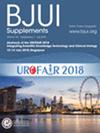Long-term oncological outcomes of bladder cancer: a population-based study with a 25-year follow-up.
IF 4.4
2区 医学
Q1 UROLOGY & NEPHROLOGY
引用次数: 0
Abstract
OBJECTIVE To describe the oncological outcomes for patients with newly diagnosed bladder cancer, as long-term oncological outcomes and natural history of different initial subtypes of diagnoses of bladder cancer are understudied. PATIENTS AND METHODS This was a prospective, multicentre population-based cohort study, where newly diagnosed patients with bladder cancer from 1995 to 1996 in Stockholm County, Sweden were followed. The primary outcome was cancer-specific mortality (CSM), separately analysed for low-grade non-muscle-invasive bladder cancer (NMIBC Low), high-grade non-muscle-invasive bladder cancer (NMIBC High), and muscle-invasive bladder cancer (MIBC). We used cumulative incidence with competing risk to assess survival outcomes. RESULTS In total, 526 patients were included, 396 had NMIBC. Out of 102 patients with T1, 37% died of bladder cancer during the 25-year follow-up. The rate of CSM for NMBIC Low was 3%, NMIBC High 26%, and MIBC 71%, respectively. For the operated patients with MIBC, the 5-year CSM was 39%. Of the 178 patients with NMIBC High, 22% progressed to MIBC, 10% had lymph node progression, and 17% progressed to metastatic disease during the follow-up. The main limitation of the study is that it was established 30 years ago. CONCLUSION In this population-based study, we found that patients with NMIBC High had a persistent risk of CSM up to 25 years from the initial diagnosis, more specifically in patients with T1 tumours. The study demonstrates the importance for optimal treatment for selective high-risk T1 patients with long life expectancy, and high risk of progression.膀胱癌的长期肿瘤预后:一项基于人群的25年随访研究
目的描述新诊断膀胱癌患者的肿瘤预后,因为对膀胱癌不同初始亚型的长期肿瘤预后和自然病史的研究尚不充分。患者与方法这是一项前瞻性、多中心人群队列研究,研究对象为1995年至1996年瑞典斯德哥尔摩县新诊断的膀胱癌患者。主要终点是癌症特异性死亡率(CSM),分别对低级别非肌肉侵袭性膀胱癌(NMIBC Low)、高级别非肌肉侵袭性膀胱癌(NMIBC High)和肌肉侵袭性膀胱癌(MIBC)进行分析。我们使用具有竞争风险的累积发生率来评估生存结果。结果共纳入526例患者,其中NMIBC患者396例。在102例T1患者中,在25年的随访期间,37%死于膀胱癌。NMIBC Low、NMIBC High、MIBC的CSM发生率分别为3%、26%和71%。手术后的MIBC患者,5年CSM为39%。在178例NMIBC高患者中,22%进展为MIBC, 10%有淋巴结进展,17%在随访期间进展为转移性疾病。这项研究的主要局限性是它是30年前建立的。结论:在这项基于人群的研究中,我们发现NMIBC高水平患者从最初诊断起持续存在CSM风险长达25年,更具体地说,是T1肿瘤患者。该研究证明了对选择性高风险T1患者进行最佳治疗的重要性,这些患者预期寿命长,进展风险高。
本文章由计算机程序翻译,如有差异,请以英文原文为准。
求助全文
约1分钟内获得全文
求助全文
来源期刊

BJU International
医学-泌尿学与肾脏学
CiteScore
9.10
自引率
4.40%
发文量
262
审稿时长
1 months
期刊介绍:
BJUI is one of the most highly respected medical journals in the world, with a truly international range of published papers and appeal. Every issue gives invaluable practical information in the form of original articles, reviews, comments, surgical education articles, and translational science articles in the field of urology. BJUI employs topical sections, and is in full colour, making it easier to browse or search for something specific.
 求助内容:
求助内容: 应助结果提醒方式:
应助结果提醒方式:


